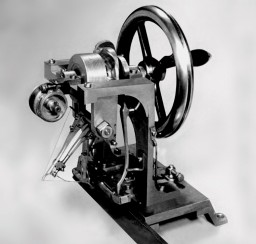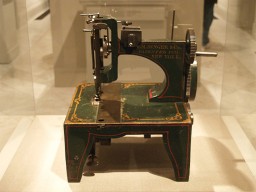 The history of sewing machine is as fascinating as the product it makes. Its constant evolution up to its present form not only brought a boon for a traditional housewife but also brought with it a revolution in the readymade clothing industry.
The history of sewing machine is as fascinating as the product it makes. Its constant evolution up to its present form not only brought a boon for a traditional housewife but also brought with it a revolution in the readymade clothing industry.
Even though Elias Howe was granted a patent on 10th of September, 1846 for an invention involving a curve eye-pointed needle carrying an upper thread and operating in a horizontal plane in conjunction with a shuttle for the lower thread to form a lock stitch, the series of invention towards building a continuous sewing machine across the world started way back in 18th century.
History of Sewing Machines
It is believed that the first workable sewing machine was invented and patented by the British inventor Thomas Saint in 1790. Earlier, in 1755, Charles Weisenthal, a German inventor, devised the first sewing machine needle, but did not produce a complete machine. Thomas Saint’s machine designed to sew leather and canvas mainly on boots used a single thread and formed a chain stitch. Instead of a needle, an awl was employed to pierce a hole through the material being sewed. Another mechanism placed the thread over the hole, and then a needle-like rod with a forked point carried the thread through to the underside of the work, where a hook caught the thread and moved it forward for the next stitch. When the cycle was repeated, a second loop was formed on the underside of the cloth with the first loop, thus forming a chain and locking the stitch. Thomas Saint’s machine, however, never progressed beyond the patent model stage. And it overlooked the Charles Weisenthal needle design.
| Main features | Year | Inventor | Country | Notes |
| 1755 | Charles T. Wiesenthal | USA | Designed and patented a double pointed needle. | |
| Looper and chain stitch, vertical needle bar and straight, forked, needle. | 1790 | Thomas Saint | England | Designed for leather boots, it formed a simple chain stitch. William Newton Wilson found the patent in 1874 and, with minor modifications to the looper mechanism a working machine was built from these plans. |
| Eye-pointed needle | 1807 | Edward | USA Chapman | For passing a thread through leather belts. |
| Eye-pointed needle | 1810 | Balthasar | Germany Krems | On a machine for making nightcaps. These are just two instances. There were others used for leather and decorative work. |
| Looper and chain stitch, overhanging arm and a presser foot in the form of a tube for the needle to pass through. | 1830 | Bartholomy Thimonnier | France | The loops were on the top of the material with the thread being pulled through from underneath by a barbed needle entering from the top. It tended to catch the cloth on its way up. The thread was hooked on to the needle by an oscillating arm, which is not on the animation. The machine had no cloth to feed, so the work had to be moved along by the operator |
| Single eye-pointed needle, shuttle and lockstitch | 1832 | Walter Hunt | USA | This machine was not very practical and employed many ideas already used by other inventors. It could not deal with a curved stitch and managed only short runs before the cloth needed resetting. |
| Curved eye-pointed needle, shuttle and lockstitch | 1846 | Elias Howe | USA | This machine was not very practical and employed many ideas already used by other inventors. It could not deal with a curved stitch and managed only short runs before the cloth needed resetting. |
In 1826, Henry Lye of Philadelphia obtained the first US Patent for a sewing device. However, his model was destroyed in a fire that swept the Patent Office leaving the description too meagre for the determination of exactly how it worked. It apparently was never manufactured.
In 1830 a French tailor, Barthelemy Thimonnier, patented the first practical sewing machine. It employed a hook-tipped needle, much like an embroidery needle, that was moved downward by a cord-connected foot treadle and returned by a spring. Like Thomas Saint’s machine, it produced a chain stitch. By 1841, the French army started using his machines to sew their uniform.

The earliest idea for a double-thread sewing machine came from the Yankee mechanical genius Walter Hunt of New York, in 1834. He also invented the safety pin and devised a machine that used a reciprocating eye-pointed needle. It worked in combination with a shuttle carrying a second needle, making an interlocked stitch comparable to that of the modem machine.
None of these machines were competitive to the hand sewing method. In 1846 Elias Howe of Massachusetts patented a sewing machine with a grooved, eye-pointed needle and shuttle. This lock stitch machine could sew nothing except straight seams, which could not be longer than the basing plate. Unsuccessful in marketing the device in America, Elias Howe went to England to adapt his machine for an English corset-maker. On 10th September 1846, after favourable litigation, he entered into the world’s first patent pool.
In 1851, Issac M. Singer patented the first rigid-arm sewing machine. Earlier, all machines employed an overhanging arm that held the needle directly and vibrated with it. His machine also included a table to support the cloth horizontally, instead of a feed bar; a vertical presser foot to hold the cloth down against the upward stroke of the needle, and an arm to hold the presser foot and the vertical needle-holding bar in position over the table. The invention of a foot treadle instead of a hand crank was a breakthrough. Parts of Issac M. Singer’s new machine were based on Elias Howe’s work.
Sewing machines continued being made to roughly the same design, until the 1900’s when the first electric machine was introduced with a motor strapped on the side. As the use of electricity spread widely, sewing machines became more popular.
The contemporary scenario: The sewing machines are now computerized to offer multi-decorative stitches or different stitch programmes and use stepper motors or sequential cams to achieve more complex patterns. Most of these machines are now manufactured in Asia with the market becoming more specialized. The latest technologies make the machines more flexible to capably perform drop feed and needle feed functions in the same machines. Another example could be a button-holing machine that offers a choice of multiple patterns for the same function.
The journey from clutch motor to servo motor and new oil-free or dry head technology is aimed at energy conservation. Needle point data can now be captured to improve efficiency and productivity of the machine. Internet and intranet applications enable easy access to all kinds of data and other information stored in the in-built computers of these machines.
Touted as the greatest revolution, only next to new age sewing technology, the range of application of ‘bonding’ or ‘welding’ technology is endless and goes from intimate to active-wear (or so-called functional garments), to denims, shoes, furniture, car seats, etc. During bonding, the machine applies a maximum pressure for fusing of the two panels of fabrics at the seams through a bonding press or an automatic carousel. The resultant seam is stronger and more flexible than the average sewn seam. This technology, though still trying to set its roots in the industry, is ultimately expected to replace sewing machines in a lot of operations.






